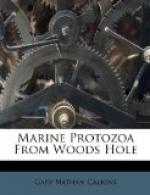Author: Gary N. Galkins
Release Date: May 5, 2006 [eBook #18320]
Language: English
Character set encoding: ISO-646-us (us-ASCII)
***Start of the project gutenberg EBOOK marine protozoa from Woods Hole***
E-text prepared by Ronald Calvin Huber, while serving
as Penobscot Bay
Watch, Rockland, Maine, and Joseph E. Loewenstein,
M.D.
Note: Project Gutenberg also has an HTML version
of this
file which includes
the original illustrations.
See 18320-h.htm
or 18320-h.zip:
(http://www.gutenberg.ne
t/dirs/1/8/3/2/18320/18320-h/18320-h.htm)
or
(http://www.gutenberg.ne
t/dirs/1/8/3/2/18320/18320-h.zip)
Contributions from the Biological Laboratory of the
U. S. Fish
Commission, Woods Hole, Massachusetts.
Marine protozoa from Woods Hole.
by
Gary N. Galkins,
Department of Zoology, Columbia University.
Bulletin of the United States Fish Commission 21:415-468, 1901
Comparatively little has been done in this country upon marine Protozoa. A few observations have been made by Kellicott, Stokes, and Peck, but these have not been at all complete. With the exception of Miss Stevens’s excellent description of species of Lichnophora I am aware of no single papers on individual forms. Peck (’93 and ’95) clearly stated the economic position of marine Protozoa as sources of food, and I need not add to his arguments. It is of interest to know the actual species of various groups in any locality and to compare them with European forms. The present contribution is only the beginning of a series upon the marine Protozoa at Woods Hole, and the species here enumerated are those which were found with the algae along the edge of the floating wharf in front of the Fish Commission building and within a space of about 20 feet. Many of them were observed in the water and algae taken fresh from the sea; others were found only after the water had been allowed to stand for a few days in the laboratory. The tow-net was not used, the free surface Protozoa were not studied, nor was the dredge called into play. Both of these means of collecting promise excellent results, and at some future time I hope to take advantage of them.
My observations cover a period of two months, from the 1st of July to the 1st of September. During that time I was able to study and describe 72 species representing 55 genera, all from the limited space mentioned above. In addition to these there are a few genera and species upon which I have insufficient notes, and these I shall reserve until opportunity comes to study them further.
I take this opportunity to express my thanks to Dr. Hugh M. Smith for many favors shown me while at Woods Hole.




